This article was medically reviewed by Shari Forschen, NP, MA. Shari Forschen is a Registered Nurse at Sanford Health in North Dakota. Shari has worked in healthcare since 1996 and her expertise lies in acute care bedside nursing on a medical oncology floor. She received her degree from Medcenter one College of Nursing in 2003 and her Family Nurse Practitioner Masters from the University of North Dakota in 2014. Shari is a member of the American Nurses Association.
There are 13 references cited in this article, which can be found at the bottom of the page.
This article has been viewed 198,984 times.
Experts agree that a stuffy nose can make it hard for your baby to breathe, which can make them very fussy. Fortunately, you can use a bulb syringe to suck out the mucus.[1] A bulb syringe is a latex or rubber bulb with a long tube at one end. When you squeeze the ball, liquid is sucked or released through an opening at the end of the tube. Research suggests that bulb syringes may also treat other common ailments, like built-up earwax.[2] However, don't use the same bulb syringe for multiple uses, as they're difficult to clean.
Steps
Suctioning an Infant’s Nose
-
1Gather your materials. Suctioning the mucus out of your infant’s nose will make it easier for him to breathe and to eat. The best time to suction your infant’s nose is before feeding him, as this will help him suck and eat. To suction your child’s nose using a bulb syringe, you will need:[3]
- Saline or prescription respiratory nose drops. Ask your pediatrician for a prescription.
- A clean bulb syringe
- Soft tissues
- A blanket (optional)
-
2Wash your hands thoroughly before and after suctioning. Your hands have bacteria on them and you don't want to introduce this into your child's nose and mouth. To wash your hands properly:[4]
- Wet your hands with warm water.
- Lather your hands by rubbing them together with soap. Wash the backs of your hands, between your fingers and under your nails.
- Scrub your hands for 20 seconds. If you need a timer, hum the tune of "Happy Birthday" two times.
- Rinse your hands under clean, running water.
- Dry your hands with a paper towel.
Advertisement -
3Lay the infant on her back. The child's face should be facing the ceiling.[5]
- You can have someone hold the infant in position gently.
- If you don't have assistance, swaddle the infant tightly in a blanket. Swaddling the infant with her arms at her sides will help to keep her still.
-
4Drop three to four drops of saline solution into one of the infant's nostrils. Keep in mind he might not like this and may squirm. Try and hold the infant still for about 10 seconds, with assistance or a swaddle. The saline will help to loosen any mucus clogging his nasal passages.[6]
- You can make your own saline solution at home, but this is not recommended, especially not for an infant. If you don't get the proportions just right, the saline can be very drying. In addition, you have to make sure you have distilled, sanitized water to mix the solution.[7]
- Instead, choose one of the many commercially available saline solutions made specifically for infants. These are inexpensive and are made especially for this purpose.
-
5Squeeze all of the air out of the bulb syringe. Use your thumb and first two fingers to apply pressure to the bulb syringe.[8]
-
6Place the tip of the bulb syringe into your child’s nostril. Let it gently sit in your child’s nostril. Slowly release your thumb, letting the air come back into the bulb syringe.[9]
- The suction will pull the mucus out of your child's nose and into the bulb. You may need to suction each nostril several times to remove all of the mucus. The mucus may be very thick, especially if your infant has a cold.
- If the mucus is too thick to go into the bulb syringe, thin it with a few drops of saline solution and then try to suction it again, gently.
-
7Remove the bulb from your infant’s nose. Squeeze the mucus out of the bulb onto a paper towel or a tissue.[10]
- Your child may have some mucus around the outside of her nostril. Be sure to wipe this away gently to prevent skin irritation.
-
8Repeat the process with the other nostril. Take care to suction carefully to remove most of the mucus in your infant's nose.
-
9Clean the bulb syringe after use. Wash the bulb syringe with warm soapy water after each use.[11]
- Make sure you rinse the syringe thoroughly to prevent soap buildup in the syringe. Squeeze the bulb several times in the soapy water to clean out the mucus. Shake the inside of the bulb before squeezing it out.
- Allow it to dry overnight before using it again or storing it.
-
10Don't overdo it. Limit suctioning your infant’s nose to four times a day to prevent irritating the lining of your infant’s nose.[12]
Giving An Enema
-
1Understand the purpose of an enema. Infant constipation is a very common problem and if other methods fail an enema may be necessary to help them. Your infant likely has constipation if she has hard stools or difficulty pooping. Talk to your pediatrician before you give your infant an enema using a bulb syringe. Sometimes enemas can cause irritation or fissures of your child’s anus, resulting in pain and stool holding.[13]
- Breast feeding is less likely to cause constipation and digestive issues than formula feeding. A small amount of magnesium in a bottle can help a baby have a bowel movement.
- You can also try gentle tummy rubs on your infant before trying an enema.
-
2Gather your materials. To give your child an enema, you will need to have the following supplies:
- A clean bulb syringe
- Olive oil
- A diaper
- Warm water
-
3Wash your hands thoroughly before and after performing an enema on your child. You will want your hands to be clean before doing this procedure. This process can be messy once your child has a bowel movement, so you will need to wash your hands again afterwards.[14]
- Make sure you wash your hands for at least 20 seconds using soap.
- Lather up your hands, including between your fingers, under your nails, and the backs of your hands.
- Rinse your hands well and dry them with a clean paper towel.
-
4Fill the bulb syringe with one to three tablespoons of warm water. To fill the syringe, squeeze the air out of it first, then place the tip of the syringe in a bowl containing the water.
- Release your thumb slowly and the syringe will fill up. Make sure the water isn't too hot. It should feel lukewarm to slightly warm to touch. You should use no more than three tablespoons of water at a time.
-
5Lubricate the end of the bulb syringe with olive oil. This will make it more comfortable for your infant during the enema.
- Take a teaspoon of olive oil and rub it on your finger.
- Coat the end of the syringe with a thin layer of oil.
-
6Insert the tip of the syringe into your child's rectum. Only insert it about a half inch.[15]
- Avoid squeezing the syringe or you will lose the water inside too early.
- This process can be unpleasant, so you may want to ask someone to help you distract your infant so he does not pay attention to his discomfort.
-
7Gently squeeze the syringe. The water will enter your child's bowel and help to loosen stool. Your infant should have a bowel movement within a couple of minutes of the enema.[16] .
- Wait a few minutes for your child to have a bowel movement. To make this process less messy, you can put a diaper on her.
- Repeat this process, if necessary.
-
8Wash the syringe after use. Clean it with hot soapy water and let it dry overnight.
- Be sure to rinse it thoroughly to avoid soap buildup. Squeeze the syringe several times in soapy water to clean it.
- Never use an enema bulb syringe for another purpose besides enemas.
Removing Ear Wax
-
1Gather your materials. If you have a buildup of wax in your ears, it may be time to flush it out using a bulb syringe and a wax softening solution. Most cases of ear wax buildup can be treated at home.[17] Before you attempt to remove ear wax, get your supplies together:
- A clean bulb syringe
- Wax softening solution. You can get this over-the-counter at your local pharmacy or use a natural remedy like baby oil, mineral oil, glycerin or hydrogen peroxide.[18]
- A clean towel
-
2Put several drops of wax softening solution into your ear canal. This will help to loosen the earwax before you try to remove it.[19]
- Tilt your head to one side.
- Drop five to 10 drops of the solution, or your chosen home remedy, into your ear canal.
- Leave the drops in for several minutes.
- Keep your head tilted or put a cotton ball in your ear canal to prevent the drops from leaking. You can wait one to two days for the wax to soften up before you use the bulb syringe.[20]
-
3Fill a bulb syringe with warm water. Do this by squeezing the air out of it first. Then, place the tip of the syringe in a bowl of warm water.[21]
- Slowly release your grip on the syringe. This will suction the warm water up into the syringe.
- Don't do this too quickly or you may end up with many air bubbles in the syringe.
-
4Place the tip of the syringe at the entrance of your ear canal. Tilt your head over a clean towel and pull your outer ear up and back. This will straighten your ear canal. Gently squeeze the water out of the syringe and into your ear canal.[22]
-
5Tip your head to the side to let the water drain. Once you have squeezed water in your ear, allow the water to drain out, as well as any dislodged wax.[23]
- When the water has drained completely, dry your outer ear with a towel.
- You can repeat this process several times to flush out the wax.
-
6Seek medical attention if the ear wax does not dislodge after several treatments. In some cases, the softening agents may only loosen the outer layer of wax and cause it to lodge deeper in your ear canal or against your eardrum. If no wax dislodges or you develop an ear ache, seek medical care for your ear.
- The doctor may repeat the irrigation attempts with the bulb syringe, suction your ear canal, or use a microscope to get a better look at the inside of your ear.
References
- ↑ https://www.cincinnatichildrens.org/health/s/suction
- ↑ https://www.northumbria.nhs.uk/wp-content/uploads/2019/12/Blocked-ears-wax-self-care-guidelines-for-patients.pdf
- ↑ https://www.nationwidechildrens.org/family-resources-education/health-wellness-and-safety-resources/helping-hands/suctioning-the-nose-with-a-bulb-syringe
- ↑ https://www.cdc.gov/handwashing/when-how-handwashing.html
- ↑ https://www.nationwidechildrens.org/family-resources-education/health-wellness-and-safety-resources/helping-hands/suctioning-the-nose-with-a-bulb-syringe
- ↑ https://www.nationwidechildrens.org/family-resources-education/health-wellness-and-safety-resources/helping-hands/suctioning-the-nose-with-a-bulb-syringe
- ↑ https://www.uofmhealth.org/health-library/hw67090
- ↑ https://www.chkd.org/patients-and-families/health-library/way-to-grow/suctioning-your-childs-nose-and-mouth/
- ↑ https://www.chkd.org/patients-and-families/health-library/way-to-grow/suctioning-your-childs-nose-and-mouth/
- ↑ https://www.chkd.org/patients-and-families/health-library/way-to-grow/suctioning-your-childs-nose-and-mouth/
- ↑ https://www.nationwidechildrens.org/family-resources-education/health-wellness-and-safety-resources/helping-hands/suctioning-the-nose-with-a-bulb-syringe
- ↑ https://myhealth.alberta.ca/Health/aftercareinformation/pages/conditions.aspx?hwid=ut1986
- ↑ https://www.aboutkidshealth.ca/Article?contentid=985&language=English
- ↑ https://www.cdc.gov/handwashing/when-how-handwashing.html
- ↑ https://patient.uwhealth.org/healthfacts/5960
- ↑ https://patient.uwhealth.org/healthfacts/5960
- ↑ https://my.clevelandclinic.org/health/diseases/14428-ear-wax-buildup--blockage
- ↑ https://health.clevelandclinic.org/ear-wax-removal-101-the-best-and-safest-ways-to-clear-clogged-ears/
- ↑ https://www.health.harvard.edu/staying-healthy/got-an-ear-full-heres-some-advice-for-ear-wax-removal
- ↑ https://www.health.harvard.edu/staying-healthy/got-an-ear-full-heres-some-advice-for-ear-wax-removal
- ↑ https://kidshealth.org/en/parents/earwax.html
- ↑ https://health.clevelandclinic.org/ear-wax-removal-101-the-best-and-safest-ways-to-clear-clogged-ears/
- ↑ https://www.health.harvard.edu/staying-healthy/got-an-ear-full-heres-some-advice-for-ear-wax-removal
About This Article
Before using a bulb syringe, wash your hands and the bulb syringe thoroughly with soap and warm water, to prevent infection. Then, if you want to use the bulb syringe to clear an infant’s nose, lay the infant on their back and drip saline solution into both nostrils. Next, press the bulb end in with your thumb and fingers, to squeeze out the air. With the bulb end still pressed down, place the syringe into the infant’s nostril and slowly release your thumb, to draw up mucus. Finally, remove the syringe, clean off any mucus, and repeat for the other nostril. Keep reading for tops from our Medical co-author on using a bulb syringe to remove earwax.

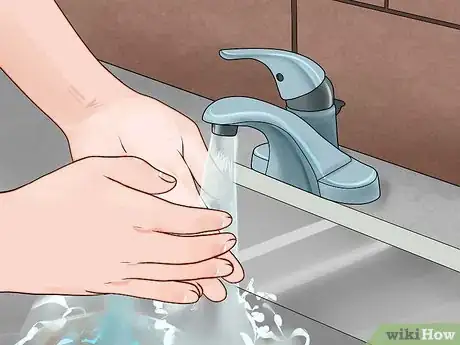
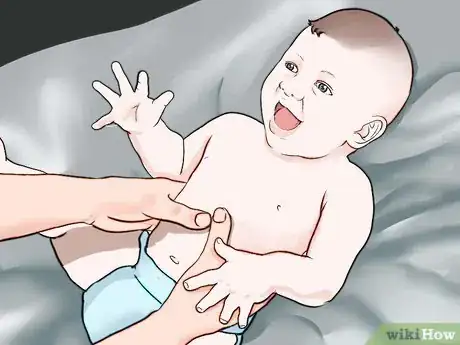
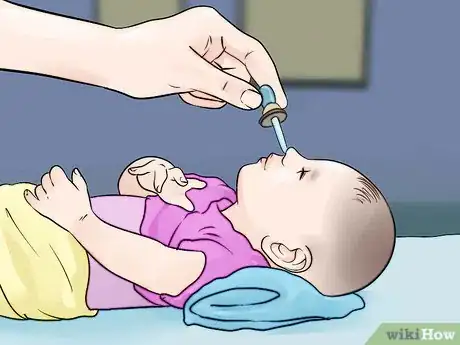
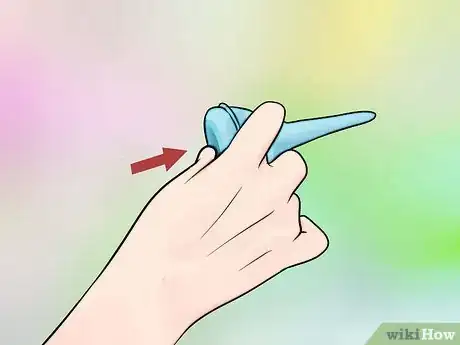
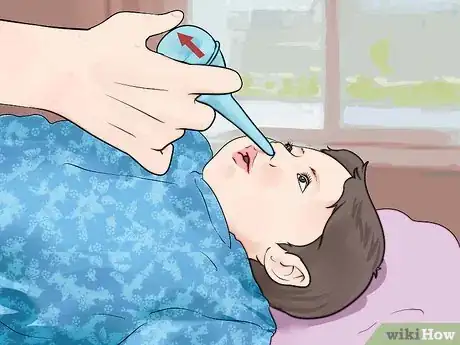
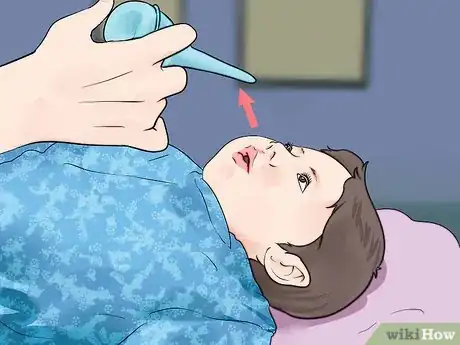
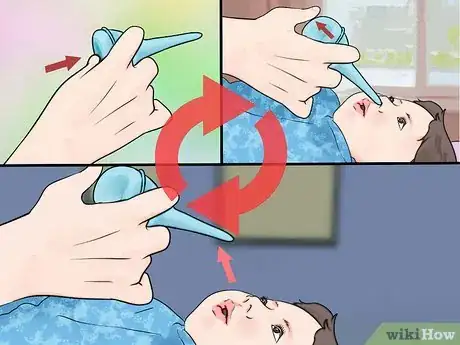
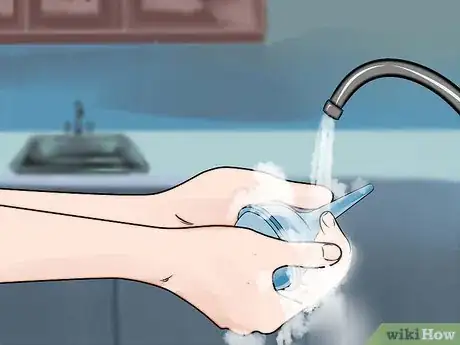

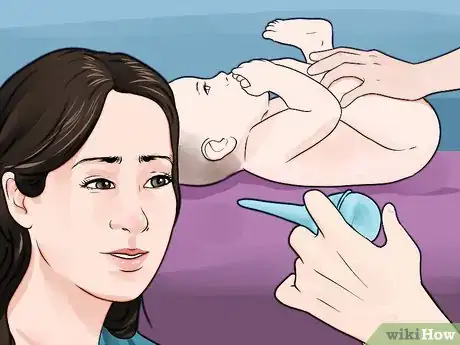
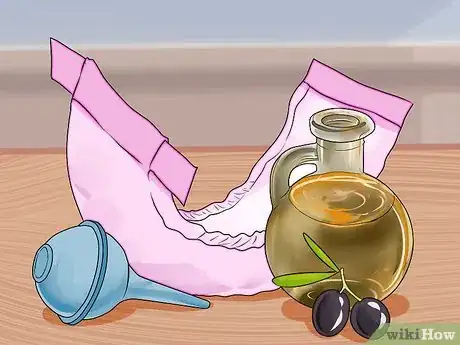
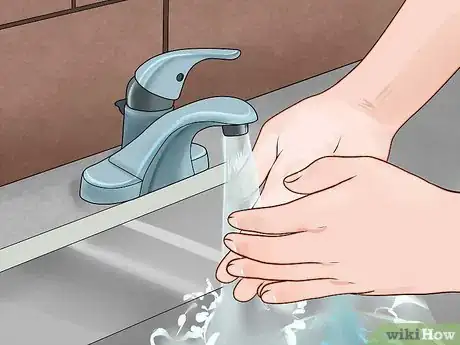
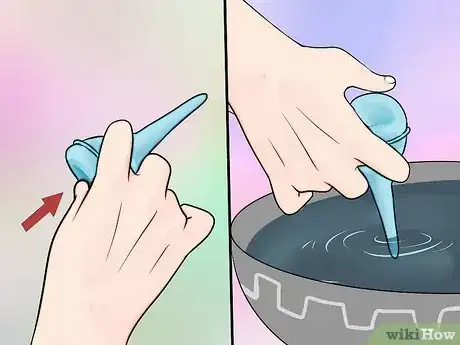
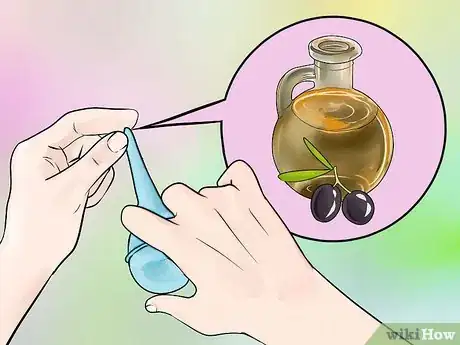
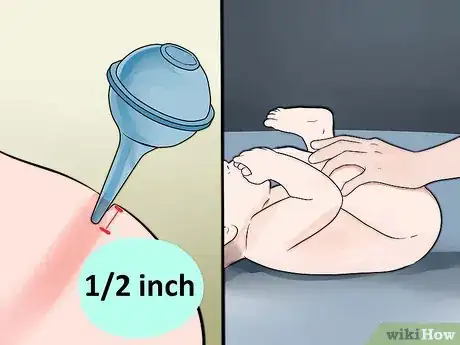


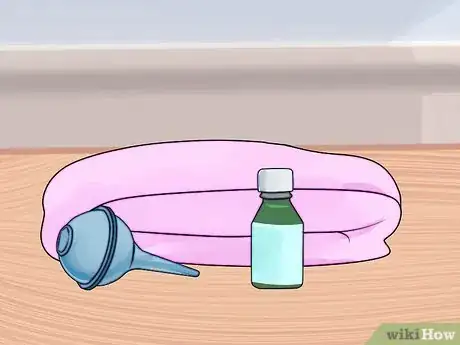
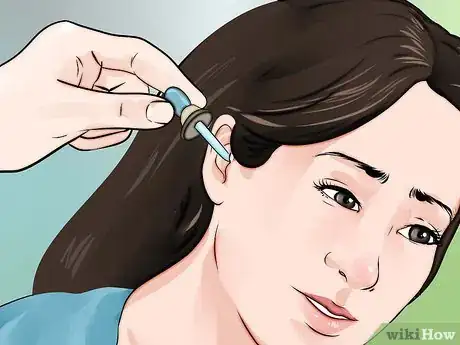

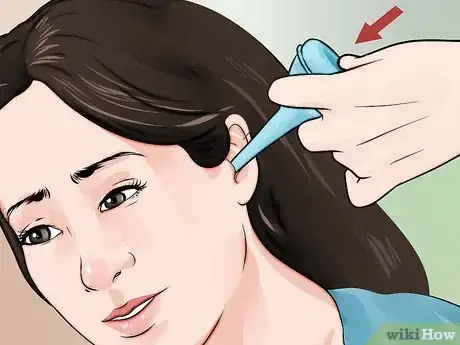


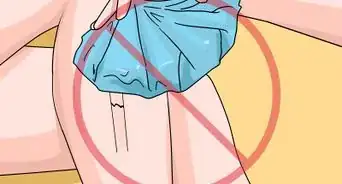
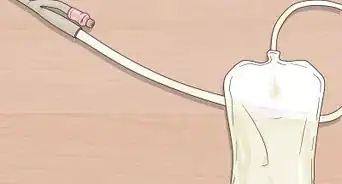



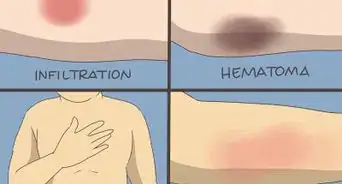
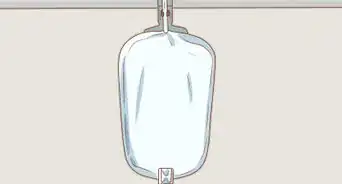

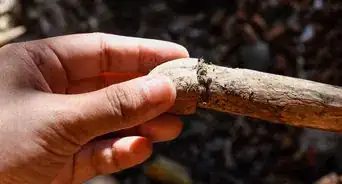
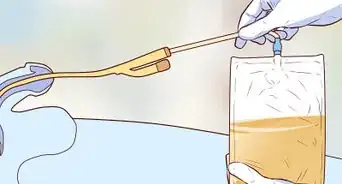
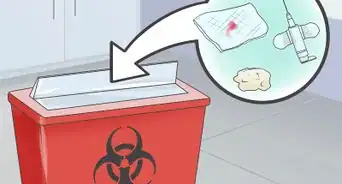











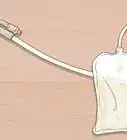
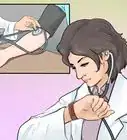




































Medical Disclaimer
The content of this article is not intended to be a substitute for professional medical advice, examination, diagnosis, or treatment. You should always contact your doctor or other qualified healthcare professional before starting, changing, or stopping any kind of health treatment.
Read More...